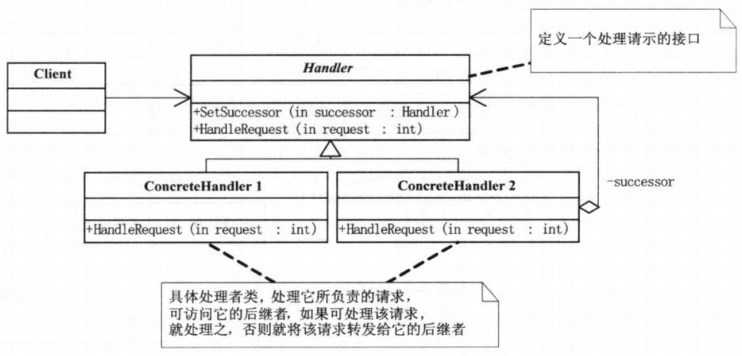标签:
一、责任链模式介绍
责任链模式:将能够处理同一类请求的对象连成一条链,使这些对象都有机会处理请求,所提交的请求沿着链传递。从而避免请求的
发送者和接受者之间的耦合关系。链上的对象逐个判断是否有能力处理该请求,如果能则就处理,如果不能,则传给链上的下一个对象。
直到有一个对象处理它为止。
场景:
1、打牌时,轮流出牌
2、接力赛跑
3、请假审批
4、公文审批
责任链UML图:

Handler:表示处理请求的接口,在这个接口里可以定义链上的下一个继承者,和一个处理请求的抽象方法。
ConcreteHandler1和ConcreteHandler2:表示具体的处理者
二、责任链模式代码实现
这里以请假的流程为例,用责任链模式来实现
首先这里定义一个请假信息的对象
1 2 3 4 5 6 7 8 9 10 11 12 13 14 15 16 17 18 19 20 21 22 23 24 25 26 27 28 29 30 31 32 | /** * 请假的基本信息 */public class LeaveRequest { private String empName;//请假人 private int leaveDays;//请假天数 private String reason;//请假理由 public LeaveRequest(String empName, int leaveDays, String reason) { super(); this.empName = empName; this.leaveDays = leaveDays; this.reason = reason; } public String getEmpName() { return empName; } public void setEmpName(String empName) { this.empName = empName; } public int getLeaveDays() { return leaveDays; } public void setLeaveDays(int leaveDays) { this.leaveDays = leaveDays; } public String getReason() { return reason; } public void setReason(String reason) { this.reason = reason; } } |
然后定义一个抽象类,来处理各个请求之间的关系。也就是UML图中的Handler部分
1 2 3 4 5 6 7 8 9 10 11 12 13 14 15 16 17 | /** * 抽象类:管理责任链上的对象处理的抽象类 */public abstract class Leader { protected String name; protected Leader nextLeader;//下一个继承者 public Leader(String name) { super(); this.name = name; } //设置责任链上的下一个继承者 public void setNextLeader(Leader nextLeader) { this.nextLeader = nextLeader; } //处理请求的抽象方法 public abstract void handleRequest(LeaveRequest leader);} |
接下来就可以开始定义处理请求的具体对象了,比如处理请假信息的:主任,经理,总经理等等。这些对象都必须继承抽象类,来处理请求。
主任对象:处理小于等于3天的假期
1 2 3 4 5 6 7 8 9 10 11 12 13 14 15 16 17 18 19 20 21 | //主任public class Director extends Leader { public Director(String name) { super(name); } /** * 责任链上对象对请求的具体处理 */ @Override public void handleRequest(LeaveRequest leader) { if (leader.getLeaveDays()<=3) { System.out.println("请假人:"+leader.getEmpName()+",天数:"+leader.getLeaveDays()+",理由:"+leader.getReason()); System.out.println("审批人:"+this.name+" 主任,审批通过!"); }else{ if (this.nextLeader != null ) {//如果有下一个继承者 //让下一个继承者处理请求 this.nextLeader.handleRequest(leader); } } }} |
经理对象:处理大于3天,小于等于10天的假期
1 2 3 4 5 6 7 8 9 10 11 12 13 14 15 16 17 18 19 20 21 | //经理public class Manager extends Leader { public Manager(String name) { super(name); } /** * 责任链上对象对请求的具体处理 */ @Override public void handleRequest(LeaveRequest leader) { if (leader.getLeaveDays()<=10) { System.out.println("请假人:"+leader.getEmpName()+",天数:"+leader.getLeaveDays()+",理由:"+leader.getReason()); System.out.println("审批人:"+this.name+" 经理,审批通过!"); }else{ if (this.nextLeader != null ) {//如果有下一个继承者 //让下一个继承者处理请求 this.nextLeader.handleRequest(leader); } } }} |
总经理对象:处理大于等于10天,小于30天的请假信息
1 2 3 4 5 6 7 8 9 10 11 12 13 14 15 16 17 18 19 20 21 22 23 | //总经理public class GeneralManager extends Leader { public GeneralManager(String name) { super(name); } /** * 责任链上对象对请求的具体处理 */ @Override public void handleRequest(LeaveRequest leader) { if (leader.getLeaveDays()<=30) { System.out.println("请假人:"+leader.getEmpName()+",天数:"+leader.getLeaveDays()+",理由:"+leader.getReason()); System.out.println("审批人:"+this.name+" 总经理,审批通过!"); }else{// if (this.nextLeader != null ) {//如果有下一个继承者// //让下一个继承者处理请求// this.nextLeader.handleRequest(leader);// } //总经理上面没人了,所以不往下发送请求。 System.out.println("请假申请,最终不通过!最终审批人:"+this.name+" 总经理"); } }} |
重要代码都写完了,下面开始测试:
1 2 3 4 5 6 7 8 9 10 11 12 13 | public static void main(String[] args) { //构建各个领导人 Leader a = new Director("张三");//主任 Leader b = new Manager("李四");//经理 Leader c = new GeneralManager("王五");//总经理 //设置各个责任链上的关系 a.setNextLeader(b);//主任的下一个审批人为经理 b.setNextLeader(c);//经理的下一个审批人为总经理 //开始请假 LeaveRequest request = new LeaveRequest("小明", 3, "旅游"); a.handleRequest(request);//小明提交了请假申请给主任 } |
控制台则打印:主任审批
请假人:小明,天数:3,理由:旅游
审批人:张三 主任,审批通过!
如果改成13天:则就是总经理审批
请假人:小明,天数:13,理由:旅游
审批人:王五 总经理,审批通过!
此时,我们发现,责任链上漏掉了副总经理,那也很好办。直接加上副总经理就行了
增加一个副总经理的对象
1 2 3 4 5 6 7 8 9 10 11 12 13 14 15 16 17 18 19 20 21 22 23 24 25 | package com.fz.chainOfResponsibility;/** * 副总经理 */public class ViceGeneralManager extends Leader { public ViceGeneralManager(String name) { super(name); } /** * 责任链上对象对请求的具体处理 */ @Override public void handleRequest(LeaveRequest leader) { if (leader.getLeaveDays()<=20) { System.out.println("请假人:"+leader.getEmpName()+",天数:"+leader.getLeaveDays()+",理由:"+leader.getReason()); System.out.println("审批人:"+this.name+" 副总经理,审批通过!"); }else{ if (this.nextLeader != null ) {//如果有下一个继承者 //让下一个继承者处理请求 this.nextLeader.handleRequest(leader); } } }} |
测试的代码呢,构造副总经理对象。然后再设置继承者的关系
1 2 3 4 5 6 7 8 9 10 11 12 13 14 15 | public static void main(String[] args) { //构建各个领导人 Leader a = new Director("张三");//主任 Leader b = new Manager("李四");//经理 //增加副总经理 Leader b2 = new ViceGeneralManager("赵四");//副总经理 Leader c = new GeneralManager("王五");//总经理 //设置各个责任链上的关系 a.setNextLeader(b);//主任的下一个审批人为经理 b.setNextLeader(b2);//经理的下一个审批人为副总经理 b2.setNextLeader(c);//副总经理的下一个审批人为总经理 //开始请假 LeaveRequest request = new LeaveRequest("小明", 19, "旅游"); a.handleRequest(request);//小明提交了请假申请给主任} |
测试结果就是:副总经理审批
请假人:小明,天数:19,理由:旅游
审批人:赵四 副总经理,审批通过!
三、责任链模式总结
实现方式:
1、链表方式:比如刚才的请假审批
2、非链表方式:通过集合,数组生成责任链更加实用,将链表上的各个对象都添加到集合中,然后通过反射给构建出来。
然后在容器里一个个的处理。(也就是说把测试代码中除了请假的其他代码都给用一个类来处理)
开发中常见场景:
1、Java的异常机制就是一个责任链模式,一个try可以对应多个cathc。如果某一个catch不匹配,则跳到下一个catch中
2、JavaScript语言中的事件的冒泡和捕获机制
3、Servlet开发中,过滤器的链式处理
4、Struts2中,拦截器的调用也是典型的责任链模式
责任链的好处:
?1、接受者和发送者都没有对方的明确信息,且链中的对象也并不知道链的结构,结果是责任链可简化对象的相互连接,它们仅需保持一个指向其
后继者的引用,而不需要保持它所有的候选继承者,大大的降低了耦合度。
请求者不用管具体哪个对象会处理,反正该请求肯定会被处理就行了
2、可以随时增加或者修改处理一个请求的结构,增加了给对象指派职责的灵活性
职责链模式(Chain of Responsibility)
标签:
原文地址:http://www.cnblogs.com/meet/p/5116440.html